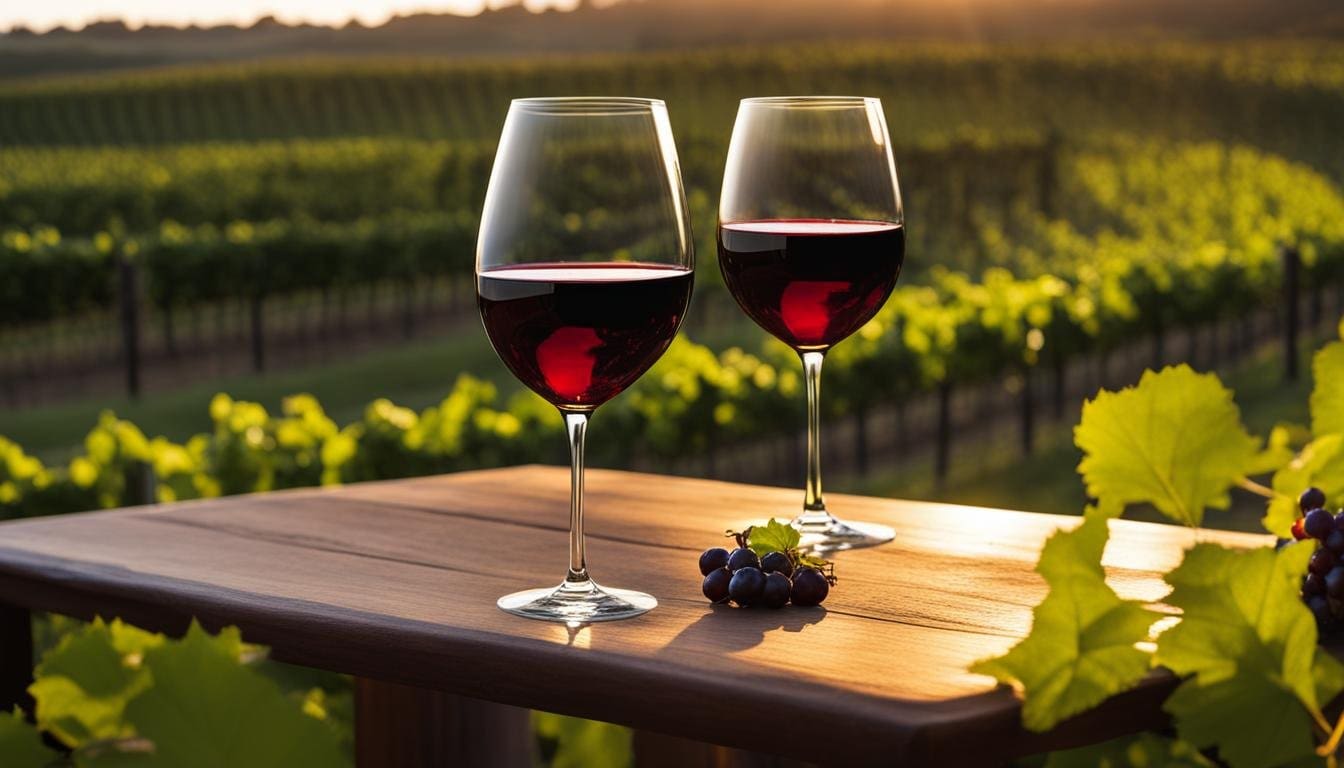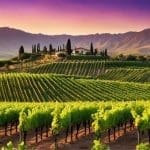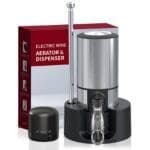This post may contain affiliate links. Please read my disclosure policy.
Cabernet Sauvignon: The King of Reds Unveiled
Introduction
Cabernet Sauvignon, pronounced “Cab-er-nay Saw-vin-yon,” is like the reigning monarch of the red wine world – bold, commanding, and deeply respected. Famed for its contribution to some of the world’s most prestigious wines, this grape variety has a reputation for complexity and longevity. Let’s delve into the realm of Cabernet Sauvignon – a wine that epitomizes power, elegance, and the art of fine winemaking.
Primary Flavours of Cabernet Sauvignon
Imagine the richest, most opulent fruit basket – that’s Cabernet Sauvignon. Each sip is a foray into a dense forest of blackcurrants, plums, and cherries, intertwined with hints of cedar, tobacco, and a dash of black pepper. It’s like a Shakespearean drama in a glass – complex, profound, and memorable.
Taste Profile
| Cabernet Sauvignon | Cabernet Sauvignon | Cabernet Sauvignon |
|---|---|---|
| Aspect | Rating out of 5 | Characteristic |
| Sweetness | 🍷 | Predominantly dry, with a depth like a philosopher's tome |
| Body | 🍷🍷🍷🍷🍷 | Full-bodied, as commanding as a king in his court |
| Tannins | 🍷🍷🍷🍷🍷 | Robust and bold, like a knight in shining armor |
| Acidity | 🍷🍷🍷 | Balanced, adding a lively edge to its character |
| Alcohol by Volume | 🍷🍷🍷🍷 | Typically around 13-15%, as warming as an evening by the fire |
| Each wine glass icon 🍷 represents one point on a 5-point scale. Cabernet Sauvignon is known for its dark fruit flavors, often accompanied by hints of spice, oak, and vanilla. It's a staple in many wine regions, including Bordeaux and Napa Valley, and is celebrated for its complexity and aging potential. | Each wine glass icon 🍷 represents one point on a 5-point scale. Cabernet Sauvignon is known for its dark fruit flavors, often accompanied by hints of spice, oak, and vanilla. It's a staple in many wine regions, including Bordeaux and Napa Valley, and is celebrated for its complexity and aging potential. | Each wine glass icon 🍷 represents one point on a 5-point scale. Cabernet Sauvignon is known for its dark fruit flavors, often accompanied by hints of spice, oak, and vanilla. It's a staple in many wine regions, including Bordeaux and Napa Valley, and is celebrated for its complexity and aging potential. |
Growing Regions for Cabernet Sauvignon
Cabernet Sauvignon’s kingdom spans the globe, with its throne firmly established in Bordeaux, France. Here, in the famed Médoc region, it plays a leading role in the storied blends of the Left Bank. The grape’s adaptability has seen it conquer new territories, notably in Napa Valley, USA, where it enjoys a cult following, as well as in regions like Chile, Australia, and South Africa.
Origin and Winemaking
Born from a chance crossing between Cabernet Franc and Sauvignon Blanc, Cabernet Sauvignon has ascended to the highest ranks of the wine world. Its thick skin and resilient nature make it a favoured choice among winemakers and connoisseurs alike. Over the years, winemaking techniques have evolved to extract the best from this noble grape, yielding wines of exceptional quality and remarkable ageing potential.
Serving Temperature
The royal decree for serving Cabernet Sauvignon is at a temperature of 15-18°C (59-64°F). At this regal range, the wine’s full spectrum of flavours and aromas can majestically unfurl. Too cold, and its complexity is imprisoned; too warm, and its alcohol may overpower the court of flavours. This ideal temperature allows Cabernet Sauvignon to exhibit its power and elegance in full splendour, offering a tasting experience fit for royalty.
Glassware
The choice of glassware for Cabernet Sauvignon is akin to selecting a crown for a king. A large, bowl-shaped red wine glass is most fitting for this noble varietal. This regal chalice allows ample room for the wine to breathe, while its broad bowl and narrower rim concentrate the wine’s rich bouquet, allowing the intricate layers of aroma to ascend gracefully to the nose. In this majestic glass, every sip of Cabernet Sauvignon is a homage to its royal stature.
No products found.
Decanting
Decanting is often a ceremonial honour bestowed upon young Cabernet Sauvignon wines. This noble practice allows the wine to breathe, softening its formidable tannins and awakening its slumbering complexities. Decanting a youthful Cabernet Sauvignon for an hour or two before serving is like granting an audience with the king, where its full character is revealed in a display of regal splendour.
Ageing
In the realm of wines, Cabernet Sauvignon is a timeless monarch, renowned for its ageing prowess. With its high tannins and acidity, it evolves gracefully over years, even decades, in the cellar. As it ages, its bold flavours mellow, and secondary notes of earth, leather, and spice emerge, adding layers of complexity to its noble profile. A well-aged Cabernet Sauvignon is a testament to the enduring legacy of this kingly grape, offering a tasting experience that is both profound and transcendent.
Food Pairings for Cabernet Sauvignon
Cabernet Sauvignon reigns supreme at the dining table, pairing magnificently with rich, hearty dishes worthy of a feast. Its robust structure and tannins make it an ideal companion for grilled red meats, braised lamb, and opulent stews. It also holds court with strong cheeses and dishes with complex, savoury flavours. The wine’s regal presence enhances the culinary experience, creating pairings that are as memorable as they are delicious.
Wine Labels
Embarking on a journey through the world of Cabernet Sauvignon via different labels unveils its majestic versatility. Below is a table showcasing esteemed brands, each representing the varietal’s kingly character:
| Cabernet Sauvignon | Cabernet Sauvignon | Cabernet Sauvignon |
|---|---|---|
| Country | Wine Label | Varietal Name & Style |
| France | Château Mouton Rothschild | Bordeaux Cabernet Sauvignon - Rich, Complex |
| USA | Screaming Eagle | Napa Valley Cabernet Sauvignon - Opulent, Cult |
| Chile | Concha y Toro | Don Melchor Cabernet Sauvignon - Elegant, Robust |
| Australia | Penfolds | Bin 707 Cabernet Sauvignon - Powerful, Balanced |
| South Africa | Meerlust | Rubicon Cabernet Sauvignon - Structured, Refined |
| Note: These brands exemplify the grandeur and diversity of Cabernet Sauvignon, from the classic Bordeaux style to the bold expressions of the New World, each a tribute to the grape’s royal lineage. | Note: These brands exemplify the grandeur and diversity of Cabernet Sauvignon, from the classic Bordeaux style to the bold expressions of the New World, each a tribute to the grape’s royal lineage. | Note: These brands exemplify the grandeur and diversity of Cabernet Sauvignon, from the classic Bordeaux style to the bold expressions of the New World, each a tribute to the grape’s royal lineage. |
Cultural and Winemaking Impact
More than just a wine, Cabernet Sauvignon is a cultural icon. It has shaped winemaking practices, inspired countless winemakers, and delighted palates across the globe. Its versatility and age-worthiness have made it a staple in cellars and a constant in the world of fine wines.
Conclusion
Cabernet Sauvignon is a grape variety that demands attention and respect. Its journey from the vineyards of France to the far corners of the wine world is a testament to its enduring appeal. Whether it’s a young, vibrant bottle or an aged, complex vintage, Cabernet Sauvignon never fails to deliver a performance worthy of a standing ovation. So, pour a glass, let the flavours unfold, and toast to the king of reds.
What are some interesting facts about Cabernet Sauvignon?
Cabernet Sauvignon is renowned for its deep colour, full body, and high tannins. It’s a natural cross between Cabernet Franc and Sauvignon Blanc grapes, originating from Bordeaux, France. This grape adapts well to various climates, making it globally popular. Wines from Cabernet Sauvignon often have flavours of blackcurrant, black cherry, and spices, and they age well, developing complex flavours over time.
What is Cabernet Sauvignon similar to?
Cabernet Sauvignon is similar to Merlot and Bordeaux blends, which often include Cabernet Franc and Merlot. These wines share a full-bodied profile, high tannins, and complex flavour profiles, suitable for ageing and pairing with rich dishes.
Where does the name Cabernet Sauvignon originate from?
The name Cabernet Sauvignon originates from the Bordeaux region of France, where the grape was first cultivated. The name combines elements from its parent grape varieties: Cabernet Franc and Sauvignon Blanc.
Which country produces the most Cabernet Sauvignon?
While originating in France, today, the United States, particularly California, is a major producer of Cabernet Sauvignon wines. This grape variety flourishes in the warm, dry climate of regions like Napa Valley and Sonoma County.
Is Bordeaux another name for Cabernet Sauvignon?
No, Bordeaux is not another name for Cabernet Sauvignon. Bordeaux refers to a wine region in France, famous for producing some of the world’s most renowned red and white wines. In Bordeaux, red wines are typically blends, often including Cabernet Sauvignon, Merlot, Cabernet Franc, Petit Verdot, and Malbec. While Cabernet Sauvignon is a key grape in many Bordeaux red blends, especially in the Left Bank area, it is distinct from the term “Bordeaux,” which represents the region and its diverse range of wines rather than a specific grape variety.
Read a comprehensive article about Cabernet Sauvignon here!
Sip smarter, subscribe now!
Subscribe for gourmet tips, event updates, travel ideas, and a free e-book on Food Pairings. Start your journey to culinary and travel excellence!















